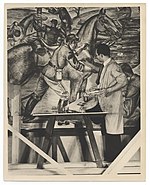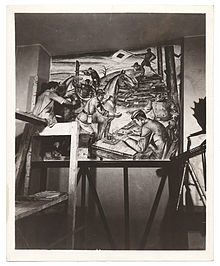Letterio Calapai | |
|---|---|
 | |
| Born | March 29, 1901 |
| Died | March 29, 1993 (aged 92) |
| Nationality | American |
| Education | Massachusetts Normal Art School |
| Movement | Realism |
| Patron(s) |
Charles Hopkinson Stanley William Hayter |
Letterio "Leo" Calapai (March 29, 1901–March 29, 1993) was an American artist and educator, who identified with the Realism movement. Calapai completed works of art for the Federal Arts Project, which was organized by the Works Progress Administration in the late 1930s and early 1940s.
Early years

A native of Boston and born to Sicilian immigrants, Calapai graduated from East Boston High School in 1923, where an interest in art grew. He then received a degree in painting from the Massachusetts Normal Art School in 1925, and is known to have later worked under Charles Hopkinson, who later financially supported his work. In 1928, Calapai moved to New York City to pursue a career in lithography, and continued to take courses at the American Artists School, the Beaux-Arts Institute of Design, and The Art Students League of New York.
In 1933, Calapai completed his first solo exhibition at the Montross Gallery in New York. In the following year, he began expanding his work in the media of printmaking, and used the works of writers William Carlos Williams and Thomas Wolfe as artistic influence.
Between 1935 and 1943, Calapai completed works for the Federal Art Project of the Works Progress Administration.
Professional career

From 1946 to 1949, Calapai worked at Atelier 17, a printmaking studio in New York, where he also met Emma Amos. With the recommendation of fellow printmaker Stanley William Hayter, Calapai was hired to establish a printmaking department at the University at Buffalo, where he would hold the most of chair until 1955, when he returned to the city. Due to Hayter, Calapai also became interested in social realism, German Expressionism, and Post-Expressionism.
In 1948, Calapai produced an illustration for the Rivers of America Series.
In 1960, Calapai established a printmaking workshop in the neighborhood of Greenwich Village, and continued to teach at such institutions as Brandeis University, New York University, and The New School for Social Research from 1955 to 1965. [1] He wed Jean Hillard in 1952. Calapai also joined the Society of American Graphic Artists. That year, Calapai moved to Chicago to teach at the University of Illinois. He would then set up a studio in nearby Glencoe.
Calapai died on his 92nd birthday in Glencoe in 1993.
Legacy
The New York Times art critic, Stuart Preston, described Calapai's works as "cataclysmic...scenes, emotional in color, form and design." [2]
Calapai's works can be found in a number of museums in the United States, including the Art Institute of Chicago, [3] Baltimore Art Museum, Brauer Museum of Art, Crystal Bridges Museum of American Art, Davis Museum, Flint Institute of Arts, Harvard Art Museums, [4] Museum of Fine Arts, Boston, [5] Metropolitan Museum of Art, National Gallery of Art, [6] Palmer Museum of Art, and the Worcester Art Museum. [7] Outside of the United States, Capalai's art is also in the Bibliothèque Nationale de France.
See also
References
- ^ "Letterio Calapai Biography | Annex Galleries Fine Prints".
- ^ "Letterio Calapai - Burchfield Penney Art Center".
- ^ "Letterio Calapai". 1902.
- ^ "From the Harvard Art Museums' collections the Pianist".
- ^ "Results – Advanced Search Objects – Museum of Fine Arts, Boston".
- ^ "Artist Info".
- ^ "Letterio Calapai – People – Worcester Art Museum".
External links
- 1901 births
- 1993 deaths
- American people of Italian descent
- People from East Boston
- Massachusetts College of Art and Design alumni
- Artists from Massachusetts
- Federal Art Project artists
- University at Buffalo faculty
- Brandeis University faculty
- Tisch School of the Arts faculty
- Parsons School of Design faculty
- University of Illinois Chicago faculty